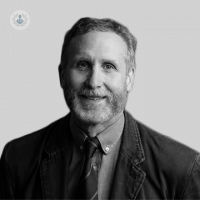Baby health: what is flat head syndrome?
Escrito por:In some cases, if a baby spends a lot of time lying on their back they can develop a flattened head, which will be a cause of concern for parents. There are two different types of flat head syndrome: plagiocephaly and brachycephaly. Paediatric consultant at the London Neurosurgery Partnership, Mr Chris Chandler frequently sees babies who have been born with, or who have even developed plagiocephaly.

There is often a slight misconception when it comes to babies having plagiocephaly and brachycephaly, as the words sound complicated enough to make even the most resilient parents fear for the worst. Here, Mr Chandler explains what flat head syndrome is exactly and why they should not be worried.
What are the different types of flat head syndrome?
The two main types of flat head syndrome are:
• Plagiocephaly – is the flattening on one side of the baby’s head, which can be caused due to continued pressure on one side of the head and causes it to look asymmetrical. The ear can be more forward than the other and there can be an unbalanced or bulging look to the face.
• Brachycephaly – is the flattening of the back of the head, which results in a wider and shorter head. This can be caused when the baby is laying down on their back for a long period of time.
What are the possible causes of flat head syndrome in babies?
Babies have soft skulls when they are born, this makes them vulnerable to conditions like this. It is also very common, affecting 1 in every 5 babies.
The causes of these conditions do vary. Here are some of the reasons as to why babies can be born with or develop plagiocephaly or brachycephaly:
• Problems in the womb – Due to increased pressure in the womb or a decrease in amniotic fluid, the baby may be a bit squashed with not much room to move around, which causes the skull to flatten.
• Premature babies – They can be vulnerable to flat head syndrome because their skulls can be underdeveloped.
• Sleeping position – Sometimes due to babies constantly sleeping on their back, it can cause the head to become flat at the back because of the constant pressure when the baby is sleeping.
• Tightened neck muscles – Some babies can have tight neck muscles which can prevent them from turning their head, this can cause the head to flatten due to increased pressure on one side.
What advice can you give to parents on managing flattened head syndrome?
Here are some suggestions to help your baby take pressure off the flattened part of the head and also strengthen neck muscles.
• Tummy time – tummy time is an important part of a baby’s development, it encourages babies to strengthen their neck muscles and improve their coordination. As they get older they will be able to lift their head and push up.
• When sleeping – the safest way for your baby to sleep is on their back, this is to prevent sudden infant death syndrome but if your baby constantly lays on a preferred side or the flattened side then you can move their head the other way.
• Feeding or holding – when feeding or holding your baby you can change the position so they are not always on one side. Moving from left arm to right arm can do this.
The thing is, the more you change your baby’s position the less chance they have of getting a flattened head. This does not mean to constantly move them in fear that this will happen, but just to be aware and if you notice your baby favours one side then you can take the steps to encourage them to move to another side.
If your baby does have a misshaped head and you are wondering if your baby’s head will ever round out then I am here to tell you that by the time your baby is one or two years old then any flattening should have improved by then and will hardly if not at all noticeable, especially as their hair grows.


